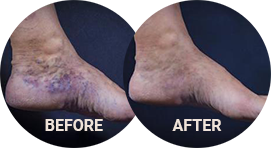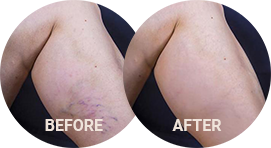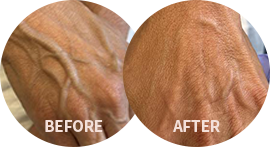Reticular Veins
Conveniently located to serve the areas of Westlake, OH

Cosmetic reticular vein sclerotherapy is a non-surgical treatment that reduces the appearance of small bluish purple veins in the lower limbs. Usually, these veins are not a serious health concern, but their appearance can be embarrassing, and the insufficient blood flow through them can sometimes cause discomfort. Sclerotherapy offers patients progressive improvement of reticular veins through a helpful injection treatment that irritates, collapses, and diminishes the vein structure. This results in fewer reticular veins, improved blood flow, and relief from discomfort. Sclerotherapy is the least-invasive way to reduce reticular veins and improve patient quality of life. [1]
Located in the Westlake, OH area, board-certified vascular surgeon Dr. David Naar provides premier vein treatments. He offers patients looking to improve the appearance of their lower limbs the chance to live their lives free of visible veins. To learn more about this treatment, set up a consultation at our office! Call (440) 641-0433 or book your appointment online.
Contents
- 1 About Reticular Veins
- 2 Sclerotherapy for Reticular Veins
- 3 Benefits of Reticular Veins Sclerotherapy
- 4 Ideal Candidates
- 5 Personal Consultation with Dr. Naar
- 6 Preparation
- 7 Procedure
- 8 Recovery
- 9 Results
- 10 Corresponding & Complementary Procedures
- 11 Cost of Reticular Vein Sclerotherapy in Westlake, OH
- 12 FAQ
- 13 References
About Reticular Veins
Arteries and veins form an important part of the vascular system. While arteries direct newly oxygenated blood from the heart, veins transport deoxygenated blood from various parts of the body back to the heart and lungs. However, blood flow may be impacted because the one-way valves that regulate flow stop working correctly in a condition known as venous insufficiency. As a result, noticeable reticular veins can develop superficially on the lower limbs, such as the thighs or ankles. While some patients may experience minor discomfort, others may not experience anything. Nevertheless, their appearance can be bothersome.
What Causes Reticular Veins?
Several lifestyle factors may contribute to the appearance of reticular veins. They include:
- Work: Patients with occupations that require them to sit or stand for long periods are more likely to develop reticular veins.
- Weight: Obesity is a common factor because the added weight puts pressure on the legs. The additional stress can affect blood flow and reduce vein efficiency.
- Genetics: You’re likely to develop reticular veins and other vascular conditions if you have immediate family members who experience similar symptoms.
- Age: Unfortunately, as the aging process progresses, the likelihood of developing venous insufficiency increases.
- Pregnancy: Becoming pregnant puts additional pressure on the lower limbs which affects blood flow and reticular veins start to show.
Sclerotherapy for Reticular Veins
Sclerosant is a mixture of chemicals that, when injected, irritates and destroys the vein in a process that causes endothelial damage. The endothelium is a protective membrane that lines blood vessels. The vein becomes blocked and eventually disappears. Reticular vein sclerotherapy uses sclerosing agents polidocanol or Sotradecol to break down the vein structure. [2] When introduced to the target area, the liquid solution irritates the blood vessel wall, causing the body to create an inflammatory response. The swelling stops blood flow and causes the vessels to shrink. The body will then absorb the vein structure back into the body. Over time, the blood vessels vanish to create an aesthetically pleasing appearance.
Benefits of Reticular Veins Sclerotherapy
Sclerotherapy treatment is an effective non-surgical alternative for reticular veins. Gradually, patients will see remarkable improvements in their legs. It can:
- Shrink blood vessels to reduce reticular, spider, and varicose veins
- Safely and efficiently treat reticular veins in a few sessions placed a few weeks apart
- Alleviate discomfort in the legs
- Help patients avoid costly surgery and extended downtime
- Boost confidence and freedom of choice with clothing
Ideal Candidates
Sclerotherapy has helped patients overcome the appearance of reticular veins caused by heredity, age, weight, or pregnancy. A consultation with Dr. Naar will confirm if the treatment can improve your condition. Candidates should:
- Be comfortable with correcting mild to moderate caser reticular veins with an injectable treatment
- Not have a history of blood clotting, blood disorders, or heart problems
- Not be pregnant or nursing
- Not be allergic to the active ingredients of sclerotherapy
- Understand the treatment does not prevent new reticular veins from forming
Personal Consultation with Dr. Naar

With a career spanning 35 years, Dr. David Naar is a Cleveland-based vascular surgeon who has built a strong reputation among patients and peers. He is an advocate for minimally invasive vein treatments, and is dedicated to finding the right procedure for you.
Once inside our consultation room, you will have the opportunity to share your experience of reticular veins with Dr. Naar. After he asks you a few essential health questions, he will evaluate the vessels based on their size, location, and appearance. His observations will lead him to develop a customized treatment plan which will outline the rewarding benefits of sclerotherapy in better detail.
To arrange a private consultation at Dr. Naar’s Westlake office, please reach out to us by calling (440) 641-0433. Or, you can make an appointment online. If you are interested in how our patients feel about their treatments, read through the reviews we’ve collected over the years. Each year we help hundreds of patients from all across the state find solutions for their unsightly leg veins.
Preparation
Only a few simple steps need to be followed before your session begins. Dr. Naar advises patients to:
- Avoid anti-inflammatory pain relievers (NSAIDs) and other blood-thinning medications until directed otherwise.
- Refrain from smoking and consuming alcohol a few days before to ensure adequate blood flow.
- Eat a small meal or snack and stay well hydrated before treatment.
- Avoid shaving or applying topical creams to the treatment area.
- Wear loose, comfortable clothing on the treatment day.
Procedure
After thoroughly cleaning the area, Dr. Naar will inject the sclerosant directly into the reticular veins with an ultra-thin needle. The solvent will irritate the internal lining of each vein, block the flow of blood, and cause the vein to collapse. [2][3] Patients may experience mild stinging throughout the process but this will subside once treatment ends. Depending on the number of veins you wish to treat, a session usually lasts around one hour. After Dr. Naar withdraws the needle, he’ll place a compression stocking and massage the treated area to evenly distribute the solution.
Recovery

The main benefit of non-surgical treatments such as sclerotherapy is that patients can resume their daily activities quickly after their procedure. However, we advise patients to avoid strenuous activities because mild feelings of soreness, swelling, redness, and itching may occur for the first two weeks. After this time, you can gradually resume other activities and remove the compression garment. While some patients may see progress in as little as one session, others may need further treatments to see improvements.
Results
You can expect optimal results and improved symptoms after a few sclerotherapy sessions. Patients who have small instances of reticular veins may see results in as little as one treatment. Those with more prominent veins may see results within 3-4 months.
Corresponding & Complementary Procedures
Dr. Naar may suggest other vein treatment options to you. At your consultation, he may recommend:
Endovenous RF Ablation Therapy
Endovenous Radiofrequency (RF) Ablation Therapy is a minimally invasive procedure that uses radiofrequency waves to treat varicose veins or chronic venous insufficiency. The heat generated from the treatment causes the collagen in the vein walls to contract and redirect blood flow to healthier veins.
Endovenous Chemical Foam Ablation
Endovenous Chemical Foam treats medium-sized varicose veins. Guided by ultrasound, Dr. Naar introduces the chemical foam to the affected vein. The chemical irritates the lining of the vein, causing it to collapse.
Cost of Reticular Vein Sclerotherapy in Westlake, OH
Sclerotherapy costs are based on individual diagnoses. The final price will depend on the size of each area and the number of sessions needed. Most insurance companies will not fund sclerotherapy unless it’s deemed medically necessary. Get in touch with the office by calling (440) 641-0433 to book a consultation, get an estimate, and determine if your insurance covers the treatment.
FAQ
What are reticular veins?
Reticular veins are small bluish purple veins that can appear in the lower limbs as a result of insufficient blood flow back to the heart. Some patients may experience discomfort or itching, while others may not experience any symptoms. Sclerotherapy is an effective way to eliminate reticular veins.
When should I seek treatment for reticular veins?
Patients should seek treatment if the presence of reticular veins is causing discomfort, embarrassment, or self-consciousness. An initial appointment with a vascular surgeon will evaluate your condition and determine if sclerotherapy is a suitable treatment option.
Will my insurance policy cover my reticular veins sclerotherapy treatment?
Many insurance policies do not cover the cost of reticular veins sclerotherapy because it is considered a cosmetic treatment. However, the cost may be covered if the condition is causing major medical problems. The best way to determine if they do is to contact your insurance company directly.
References
- Bertanha, M., Jaldin, R. G., Moura, R., Pimenta, R. E. F., Mariúba, J. V. de O., Lúcio Filho, C. E. P., Alcantara, G. P., Padovani, C. R., Yoshida, W. B., & Sobreira, M. L. (2017). Sclerotherapy for Reticular Veins in the Lower Limbs: A Triple-Blind Randomized Clinical Trial. JAMA Dermatology, 153(12), 1249–1255. https://doi.org/10.1001/jamadermatol.2017.3426
- Nakano, L. C., Cacione, D. G., Baptista Silva, J. C., & Flumignan, R. L. (2017). Treatment for telangiectasias and reticular veins. The Cochrane Database of Systematic Reviews, 2017(7). https://doi.org/10.1002/14651858.CD012723
- Worthington-Kirsch, R. L. (2005). Injection Sclerotherapy. Seminars in Interventional Radiology, 22(3), 209–217. https://www.ncbi.nlm.nih.gov/pmc/articles/PMC3036277/




